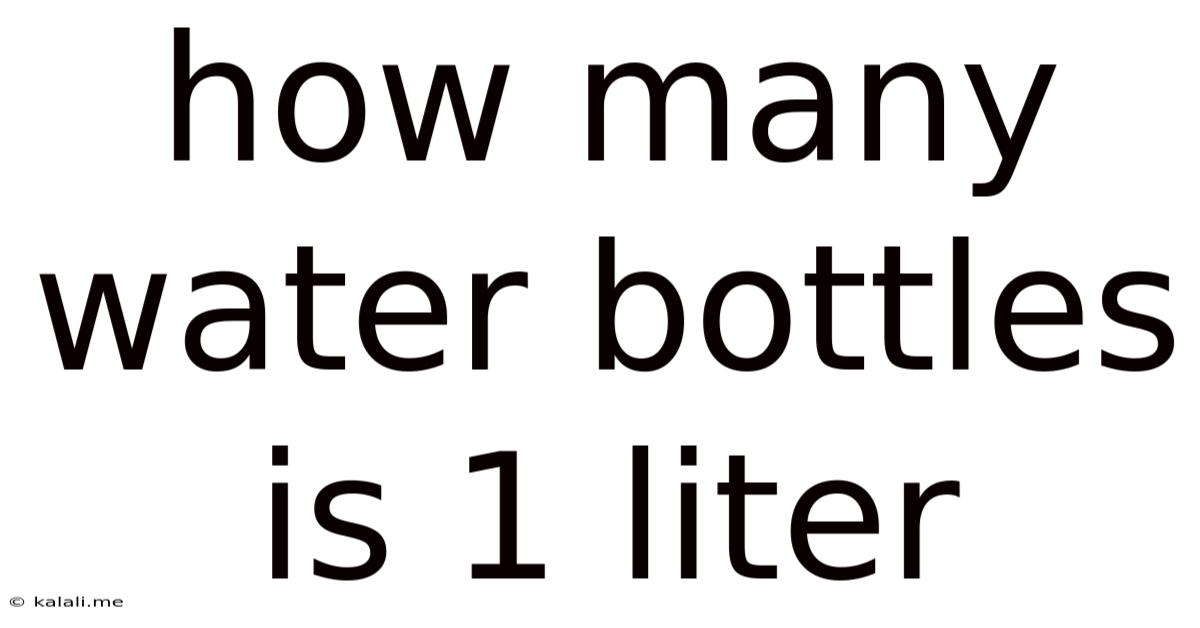How Many Water Bottles Is 1 Liter
Kalali
Jul 13, 2025 · 4 min read

Table of Contents
How Many Water Bottles is 1 Liter? Decoding Volume and Bottle Sizes
Understanding liquid measurements can be surprisingly tricky, especially when dealing with everyday items like water bottles. The question, "How many water bottles is 1 liter?" doesn't have a simple answer. It depends entirely on the size of the water bottles you're considering. This comprehensive guide will delve into the intricacies of volume measurements, explore common water bottle sizes, and provide you with the tools to calculate the number of bottles needed to equal one liter. We'll also cover practical applications and considerations for various scenarios.
Understanding Liters and Milliliters:
Before we tackle water bottle calculations, let's establish a firm grasp of the metric system's volume units. A liter (L) is the fundamental unit of volume in the metric system. It's a relatively large unit, often used for larger quantities of liquids. A milliliter (mL), on the other hand, is one-thousandth of a liter (1 L = 1000 mL). Understanding this relationship is crucial for converting between different volume measurements and determining how many smaller water bottles make up a liter.
Common Water Bottle Sizes:
Water bottles come in a dizzying array of sizes, making a direct answer to our initial question difficult. However, some sizes are more prevalent than others. Here are some common sizes you might encounter:
- 250 mL (8.5 fl oz): This is a relatively small bottle, often found in individual servings or as part of a multi-pack.
- 330 mL (11.2 fl oz): A slightly larger size, often seen in smaller beverage bottles or individual water bottles.
- 500 mL (16.9 fl oz): This is a very common size for water bottles, offering a substantial amount of liquid.
- 600 mL (20.3 fl oz): A somewhat larger size, less common than 500 mL.
- 750 mL (25.4 fl oz): Getting into larger bottle sizes, frequently used for sports drinks or larger individual servings.
- 1000 mL (33.8 fl oz) or 1 Liter: This is a whole liter, so the question is solved with just one bottle.
Calculations: How Many Bottles Make Up 1 Liter?
Now that we've established common water bottle sizes, let's calculate how many of each size it takes to equal one liter (1000 mL):
- 250 mL bottles: 1000 mL / 250 mL/bottle = 4 bottles
- 330 mL bottles: 1000 mL / 330 mL/bottle ≈ 3.03 bottles (You'd need 4 bottles to have more than a liter)
- 500 mL bottles: 1000 mL / 500 mL/bottle = 2 bottles
- 600 mL bottles: 1000 mL / 600 mL/bottle ≈ 1.67 bottles (You'd need 2 bottles to exceed a liter)
- 750 mL bottles: 1000 mL / 750 mL/bottle ≈ 1.33 bottles (You'd need 2 bottles to have more than a liter)
Practical Applications and Considerations:
The calculations above provide a theoretical answer. In practical situations, several factors might influence the actual number of bottles:
- Bottle Variation: Manufacturers might have slight variations in their stated bottle capacities.
- Filling Level: Bottles are rarely filled to the absolute brim. There's usually some headspace left.
- Intended Use: If you need precisely one liter, using 500ml bottles is the most practical approach, even though it results in a little extra. For less precise situations, approximations based on the calculations above can suffice.
Beyond Water Bottles: Understanding Volume in Different Contexts:
The principle of volume measurement extends far beyond water bottles. Understanding liters and milliliters is vital in various contexts, including:
- Cooking and Baking: Recipes often call for specific liquid volumes.
- Medicine: Dosage instructions frequently specify liquid amounts in milliliters.
- Gardening: Watering plants often involves measuring liquid quantities.
- Scientific Experiments: Accurate volume measurements are crucial for accurate and reliable results.
Tips for Accurate Measurement:
While measuring liquids, here are some useful tips for accuracy:
- Use a Measuring Jug or Cup: For accurate measurements, use a graduated cylinder or measuring jug clearly marked with milliliters and liters.
- Read the Meniscus: When reading liquid levels, look at the bottom of the meniscus (the curved surface of the liquid).
- Avoid Air Bubbles: Ensure there are no air bubbles trapped in the liquid when measuring.
- Check Bottle Labels: Always check the bottle's label for the exact volume it contains.
Conclusion: More Than Just a Number
The seemingly simple question, "How many water bottles is 1 liter?" reveals a deeper understanding of volume measurements, common bottle sizes, and the importance of precise calculations in different contexts. While the number of bottles needed varies depending on the size, understanding the principles discussed here allows you to confidently determine the appropriate number of bottles required for any given situation. By applying these principles and considerations, you'll be better equipped to handle volume measurements in various aspects of your daily life. Remember to always prioritize accuracy and choose the appropriate measurement tools for the task at hand. From cooking to scientific experiments, mastering volume measurement empowers you with greater precision and control.
Latest Posts
Latest Posts
-
Is Olive Oil A Pure Substance Or Mixture
Jul 14, 2025
-
How Much Is A Bushel Of Green Beans
Jul 14, 2025
-
What Food Category Does French Fries Fall Under
Jul 14, 2025
-
Looking Forward To Be Working With You
Jul 14, 2025
-
How Many Words Can You Make Out Of Thanksgiving Day
Jul 14, 2025
Related Post
Thank you for visiting our website which covers about How Many Water Bottles Is 1 Liter . We hope the information provided has been useful to you. Feel free to contact us if you have any questions or need further assistance. See you next time and don't miss to bookmark.